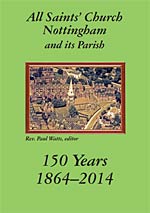Book reviews, Winter 2014-15

ALL SAINTS' CHURCH NOTTINGHAM and its Parish -150 Years 1864-2014
Edited by Rev. Paul Watts.
This A4, 20 page booklet is available from St. Peter's Church, Nottingham; the Five Leaves bookshop, Nottingham, from the church website or by post with enquiries to wattses@yahoo.co.uk
All Saints' is a city centre parish which borders the General Cemetery, includes the Arboretum and runs along Gregory Boulevard and back up Bentinck Road. Nowadays it is part of a joint City Centre Parish along with two other churches, all three of which appear to be supportive of each other.
The church is not well known, situated in a position which is just outside the city centre in an area of what are now houses converted to shared accommodation and in an area populated by students with Nottingham Trent University on its doorstep. Its spire is, however, prominent within its surroundings and the building itself is well worth a visit.
The area where the church stands was known in the past as the Sandfields. This area was developed following the Parliamentary Acts of the 1840s which opened up the town to development and by i860 the area had housing and new parishes were being formed to provide for the spiritual needs of this increasing population.
A wealthy silk merchant, William Windley, spent £10,000 in building the church of All Saints'. The church, vicarage, parish rooms and a verger's house were completed in 1864 and the first vicar was Rev. Edwin Gyles, MA.
This booklet states its purpose as ...to record and recognise the significance of All Saints' with its parish over the past 150 years and to highlight the chief issues, hopes and fears of the people involved. The booklet achieves this but in a rather sketchy manner in the eyes of this reviewer.
The first section is a part of a document written in 1954 in celebration of the church's 90th birthday (the full text is available on the church's web site and as a separate booklet); the second section was written in 2014 to recognise the 150th anniversary of the church.
There are some very useful maps and diagrams included. A section considers the potential effect that the Nottingham Civic Centre proposals of 1963 would have had on the parish and traces the subsequent history of the area and the changes in status of the population.
Another section covers what is described as a 'brief history of the church to 1954 and is followed by a section looking at the parish subsequent to 1954.
Brief details are given of the vicars involved and of the Institute which was part of the site. The final section considers the current position of the parish and raises questions about its future.
The back cover has a short resume of the parish in World War One which is contributed by Rachel Farrand and a bibliography and web site address list.
This is a very useful document and deserves a place on the bookshelf of anyone with an interest in Nottingham as well as in the city's church history. The information provides a platform for developing the history into a more detailed research project. Rev. Wells has added to our knowledge of the city and its parishes.